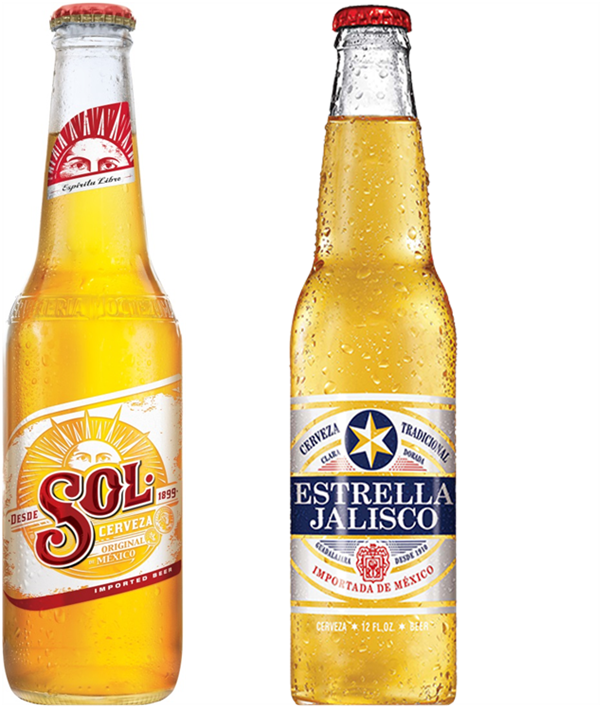The two largest U.S. brewers and longstanding competitors are each trying to crack the Mexican import market.
MillerCoors, which in October assumed control of U.S. sales and marketing for Sol under a 10-year licensing agreement with Heineken, plans to re-launch the brand in 2018 with a national advertising campaign. Anheuser-Busch is planning a push of its own behind Estrella Jalisco for 2018, including an expansion of distribution and tie-ins with the sports and entertainment industries.
It’s of little surprise that both companies are making a play in the Mexican import space, one of the beer industry’s few bright spots amid an overall market slogging through a downturn. While sales of American premium and economy lagers have tipped into the red, Mexican imports have booked double-digit growth.
With a category still on the rise, favorable demographic trends and a robust sales and distribution network, the top two U.S. brewers have a path to success with their entries, says Kevin Lane Keller, professor of marketing at the Tuck School of Business at Dartmouth College. But they’ve got to thread the needle on marketing and branding.
“There are opportunities for them, but they’re going to have to find a space, a reason for being, a reason for drinking,” Keller says. That means “executing well against that with total brand communications and packaging.”
Mexican imports with authenticity or a heritage story to tell can capitalize by reaching target consumers with something that appeals to them, he says. “The notion of trying to tap into heritage, roots and really, the authenticity, that’s the angle where I think there’s the biggest opportunity.”
From 'the heart of Mexico'
That’s also the exact spot MillerCoors is aiming for with its Sol re-launch, says Matt Reischauer, director of brand marketing for the MillerCoors economy portfolio and Mexican imports.
“Sol is a beer with a very rich history and a compelling story that’s real and true,” he says. “It’s from the heart of Mexico and it’s steeped in the culture of the country. There’s no world in which I could envision Sol not having a right to play in this market.”
MillerCoors views Sol as a unique proposition that’s incremental to the Mexican import segment, meaning it will try to bring in new legal-age drinkers who may otherwise be drinking premium lights, wine and spirits and so on.
Reischauer's team is particularly focused on connecting with bicultural Mexican-American drinkers between ages 21 and 29 with a message grounded in authenticity and optimism. These legal-age drinkers, who value their heritage and seek a connection with their home country (or their parents’ home country), “want a beer that connects with them and represents the values important to them,” Reischauer says.
“We’re brushing off a hidden gem,” he says. “It’s a marketer’s dream to be able to engage with a brand or discover a brand that’s been a little bit latent in America and give it its opportunity to shine.”
The Corona-Modelo juggernaut
There’s a clear role model for how to successfully build a Mexican brand over the long haul: Corona Extra.
Constellation Brands “really nailed it” with Corona’s “beach-in-a-bottle” premise and the ritual of forcing a lime wedge down a clear, long-necked bottle, Keller says. “The momentum they’ve had is incredible.”
The company has succeeded in part because of demographic tailwinds, says Benj Steinman, publisher of the industry publication Beer Marketers Insights. “But they’ve obviously gone way beyond that, especially with Corona, which has broad general-market appeal. They’ve also benefited from a very consistent marketing platform and they’ve applied consistent pressure on marketing with messages that have stayed consistent and resonated with consumers.”
It’s not just Corona. Modelo has been growing even faster and is on pace to overtake Corona if current trends hold. Modelo sales are up 20.7 percent on an 18.8 increase in volume year-to-date, according to Nielsen all-outlet data, including convenience, through Nov. 18. Corona, meanwhile is up 6.5 percent on a 4.7 percent rise in volume.
Replicating this kind of success is not going to be easy, he says.
A 2018 turnaround?
That’s something AB knows first-hand. The brewer made a push into the space in 2014 with Montejo, a brand that carried some authenticity and made an initial splash, but never established an enduring connection with consumers, Steinman says.
AB has since invested very little in the brand, appearing to shift its attention to Estrella Jalisco. Sales of Montejo are down 72.4 percent on a 72.6 percent drop in volume year-to-date through Nov. 18, per Nielsen. It is one of the smallest Mexican import brands sold in the U.S., per Nielsen.
Company spokespeople did not reply to a request for comment.
Estrella Jalisco, meanwhile, is down a more-modest 6.2 percent on a 7.7 decline in volume year-to-date. But AB has said it plans a major investment in the brand in 2018; it already got substantial media exposure during the 2017 World Series with a giant in-stadium sign at Dodger Stadium.
Sol also is down for the year; sales are off 17.3 percent on a 17.7 drop in volume, per Nielsen.
“You’re both going to have to come up with something exciting to make it a decent proposition” for retailers, wholesalers and, of course, consumers, Steinman says. But if any companies have the wherewithal and heft to pull it off, it’s MillerCoors and Anheuser-Busch.

